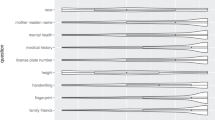Abstract
Greatly increased concern about the confidentiality of social records now jeopardizes the ability of social scientists to conduct research. A new “confidential method” is described that can facilitate the work of the researcher and also maintain the privacy of the researched. This method is called “Weighing the Evidence” or, more simply, the WEIGHT method. The WEIGHT method groups social records according to intervals of interest to the researcher and then uses a simple weighing procedure to estimate the incidence and distribution of cases. Two studies—one using simulated data and one using real data on handgun purchases—suggest that the WEIGHT method is characterized by high levels of both reliability and validity. Ten hypothetical cases are described in which the WEIGHT method would make possible research that would other wise be prevented by the confidential nature of the data involved.
Similar content being viewed by others
References
American Association for Public Opinion Research 1977 “Code of professional ethics and practices.” By-Laws, May.
American Psychological Association 1973 Ethical Principles in the Conduct of Research with Human Participants. Washington, DC: American Psychological Association.
American Sociological Association 1971 Code of Ethics. Washington, DC: American Sociological Association.
American Statistical Association 1977 “Report of Ad Hoc Committee on Privacy and Confidentiality.” The American Statistician (May):59–78.
Archer, D. and L. Erlich Forthcoming “Traces of fear: The response to extraordinary violence.”
Archer, D. and R. Gartner 1984 Violence and Crime in Cross-National Perspective. New Haven: Yale University Press.
Boruch, R. F. and J.S. Cecil 1980 Assuring the Confidentiality of Social Research Data. Philadelphia: University of Pennsylvania Press.
Campbell, D. T., R. F. Boruch, R. D. Schwartz, and J. Steinberg 1977 “Confidentiality-preserving modes of access to files and to interfile exchange for useful statistical analysis.” Evaluation Quarterly 1:269–300.
Cook, S. W. 1976 “Ethical issues in the conduct of research in social relations.” Pp. 199–249 in C. Selltiz, L. S. Wrightsman, and S. W. Cook (eds.), Research Methods in Social Relations. New York: Holt.
Cook, T. D. and D. T. Campbell 1979 Quasi-Experimentation: Design and Analysis Issues for Field Settings. Chicago: Rand McNally.
Divorski, S., A. C. Gordon, and J. P. Heinz 1973 “Public access to government information: A field experiment.” Northwestern University Law Review 68:240–274.
Erikson, K. T. 1967 “A comment on disguised observation in sociology.” Social Problems 14:366–373.
Gordis, L. and E. Gold 1980 “Privacy, confidentiality, and the use of medical records in research.” Science 107:153–156.
Kelman, H. C. 1968 A Time to Speak: On Human Values and Social Research. San Francisco: Jossey-Bass.
Milgram, S. 1977 The Individual in a Social World: Essays and Experiments. Reading, MA: Addison-Wesley.
National Academy of Sciences 1975 Protecting Individual Privacy in Evaluation Research. Washington, DC: National Academy of Sciences.
Office of Federal Statistical Policy and Standards, U.S. Department of Commerce 1978 Report of Statistical Disclosure and Disclosure-Avoidance Techniques. Washington, DC: U.S. Government Printing Office.
Office of Science and Technology, Executive Office of the President 1967 Privacy and Behavioral Research. Washington, DC: U.S. Government Printing Office.
Privacy Act of 1974 1974 U.S. Code 1976 Title 5, Section 552A. 88 stat. 1896.
Smith, M. B. 1974 Humanizing Social Psychology. San Francisco: Jossey-Bass.
U.S. Privacy Protection Study Commission 1977 Personal Privacy in an Information Society. Washington, DC: U.S. Printing Office.
Webb, E. J., D. T. Campbell, R. D. Schwartz, and L. Sechrest 1966 Unobtrusive Measures: Nonreactive Research in the Social Sciences. Chicago: Rand McNally.
Author information
Authors and Affiliations
Additional information
This project was assisted by a fellowship from the German Marshall Fund. The authors are indebted to the following people for helpful comments and advice: Donald T. Campbell, Elliot Aronson, Meredith Gould, David Harrington, John I. Kitsuse, Thomas F. Pettigrew, Alan Ritch, Robert Rosenthal, M. Brewster Smith, and Candace West.
Rights and permissions
About this article
Cite this article
Archer, D., Erlich, L. Weighing the Evidence: A new method for research on restricted information. Qual Sociol 8, 345–358 (1985). https://doi.org/10.1007/BF00988844
Issue Date:
DOI: https://doi.org/10.1007/BF00988844




